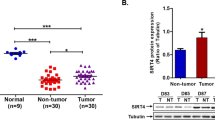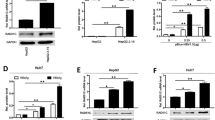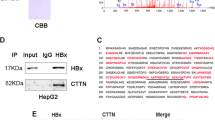Abstract
Hepatitis B virus X (HBx) protein implicated in the development of liver cancer may inhibit the function of p53 tumor suppressor protein through cytoplasmic retention of p53 protein. Here, we attempt to investigate whether the functional inhibition of p53 protein by HBx protein is reversible. First, we provide the evidence for the association of endogenous p53 protein with HBx by co-immunoprecipitation in stable Chang cells that express HBx protein in an inducible manner (ChangX-34). By immunofluorescence microscopy, the major location of p53 protein of ChangX-34 cells was confirmed at the nuclear periphery as well as in the cytoplasm where HBx protein is mainly expressed. Surprisingly, anticancer drug, adriamycin induces the nuclear translocation of p53 protein sequestered in the cytoplasm. This change is accompanied by the restoration of p53 activity, which results in increased transcriptional activity at the p53-responsive DNA elements as well as increase of p21WAF1 mRNA expression. Further, we observed the induction of cell death and G1 arrest in these cells upon adriamycin treatment regardless of HBx expression. Together, we demonstrate that functional inhibition of p53 protein through its cytoplasmic retention by HBx protein is reversible. These results may be extended into other tumors of which p53 activity is modulated by viral oncoproteins.
This is a preview of subscription content, access via your institution
Access options
Subscribe to this journal
Receive 50 print issues and online access
$259.00 per year
only $5.18 per issue
Buy this article
- Purchase on Springer Link
- Instant access to full article PDF
Prices may be subject to local taxes which are calculated during checkout






Similar content being viewed by others
References
Amundson SA, Myers TG and Fornace Jr AJ. . 1998 Oncogene 17: 3287–3299.
Becker SA, Lee T-H, Butel JS and Slagle BL. . 1998 J. Virol. 72: 266–272.
Benn J and Schnieder RJ. . 1994 Proc. Natl. Acad. Sci. USA 91: 10350–10354.
Benn J, Su F, Doria M and Schnieder RJ. . 1996 J. Virol. 70: 4978–4985.
Bunz F, Hwang PM, Torrance C, Waldman T, Zhang Y, Dillehay L, Williams J, Lengauer C, Kinxler KW and Vogelstein B. . 1999 J. Clin. Invest. 104: 263–269.
Cheong J-H, Yi M-K, Lin Y and Murakami S. . 1995 EMBO J. 14: 143–150.
Chresta CM, Masters JRW and Hickman JA. . 1996 Cancer Res. 56: 1834–1841.
Doitsh G and Shaul Y. . 1999 Oncogene 18: 7506–7513.
Elmore LW, Hancock AR, Chang S-F, Wang X-W, Chang S, Callahan CP, Geller DA and Harris CC. . 1997 Proc. Natl. Acad. Sci. USA 94: 14707–14712.
Giaccia AJ and Kastan MB. . 1998 Genes Dev. 12: 3158–3168.
Gonin S, Diaz-Latoud C, Richard MJ, Ursini MV, Imbo A, Manero F and Arrigo AP. . 1999 Oncogene 18: 8011–8023.
Greenblatt MS, Feitelson MA, Zhu M, Bennett WP, Welsh JA, Jones R, Borkowski A and Harris CC. . 1997 Cancer Res. 57: 426–432.
Harris MP, Sutjipto S, Wills KN, Hancock W, Cornell D, Johnson DE, Gregory RJ, Shepard M and Maneval DC. . 1995 Cancer Gene Ther. 3: 121–130.
Haviv IM, Shamay G, Doitsh Y and Shaul Y. . 1998 Mol. Cell. Biol. 18: 1562–1569.
Henkler F, Wassem N, Golding MHC, Alison MR and Koshy R. . 1995 Cancer Res. 55: 6084–6091.
Höhne M, Schaefer S, Seifer M, Feitelson MA, Paul D and Gerlich WH. . 1990 EMBO J. 9: 1137–1145.
Houghton JA. . 1999 Curr. Opin. Oncol. 11: 475–481.
Jiang D, Srinivasan A, Lozano G and Robbins PD. . 1993 Oncogene 8: 2805–2812.
Kekulë AS, Lauer U, Weiss L, Luber B and Hofschneider PH. . 1993 Nature 361: 742–745.
Kim C, Koike K, Saito I, Miyamira T and Jay G. . 1991 Nature 351: 317–320.
Kim H, Lee H and Yun Y. . 1998a J. Biol. Chem. 273: 381–385.
Kim J-R, Kim S-Y and Kim J-H. . 1998b Exp. Mol. Med. 30: 145–149.
Klein NP, Bouchard MJ, Wang LH, Kobarg C and Schnieder RJ. . 1999 EMBO J. 18: 5019–5027.
Lee H, Lee Y-H, Huh Y-S, Moon H and Yun Y. . 1995 J. Biol. Chem. 270: 31405–31412.
Lee Y-H and Yun Y. . 1998 J. Biol. Chem. 273: 25510–25515.
Lin Y, Nomura T, Yamashita T, Dorjsuren D, Tang H and Murakami S. . 1997 Cancer Res. 57: 5137–5142.
Macguire HF, Hoeffer JP and Siddiqui A. . 1991 Science 252: 842–844.
McCormick F. . 1999 Cancer J. 5: 139–144.
McCurrach ME, Connor TMF, Knudson CM, Korsmeyer SJ and Lowe SW. . 1997 Proc. Natl. Acad. Sci. USA 94: 2345–2349.
Morgan SE and Kastan MB. . 1997 Cancer Res. 71: 1–25.
Müller M, Strand S, Hug H, Heinemann E-M, Walczak H, Hoffman WJ, Stremmel W, Krammer PH and Galle PR. . 1997 J. Clin. Invest. 99: 403–413.
Natoli G, Avantaggiati ML, Chirillo P, Marzio E, Collepardo D, Falco M, Balsano C and Levrero M. . 1995 J. Hepatol. 22: 14–20.
Oren M. . 1999 J. Biol. Chem. 274: 36031–36034.
Price BD and Park SJ. . 1994 Cancer Res. 54: 896–899.
Qin S, Schroder CH, Hofmann WJ, Otto G, Pichlmayr R and Bannasch P. . 1998 Hepatology 27: 1109–1120.
Quadri I, Maguire HF and Siddiqui A. . 1995 Proc. Natl. Acad. Sci. USA 92: 1003–1007.
Rubenwolf S, Schutt H, Nevels M, Wolf H and Dobner T. . 1997 J. Virology 71: 1115–1123.
Scheffner MB, Werness BA, Huibregtse JM, Levine AJ and Howley PM. . 1990 Cell 63: 1129–1136.
Selvakumaran M, Lin H-K, Miyashita T, Wang HG, Krajewski S, Reed JC, Hoffman B and Libermann D. . 1994 Oncogene 9: 1791–1798.
Takada S, Kaneniwa N, Tsuchida N and Koike K. . 1997 Oncogene 15: 1895–1901.
Teodoro JG and Branton PE. . 1997 J. Virology 71: 3620–3627.
Thomas MG, Matlashewski G, Pim D and Banks L. . 1996 Oncogene 13: 265–273.
Tibbetts RS, Brumbaugh KM, Williams JM, Sarkaria JN, Cliby WA, Shieh S-Y, Taya V, Prives C and Abrham RT. . 1999 Genes Dev. 13: 152–157.
Truant R, Antunovic J, Greenblatt J, Prives C and Chromlish JA. . 1995 J. Virol. 69: 1851–1858.
Ueda H, Ullrich S, Gangemi J-D, Kappel CA, Ngo L, Feitelson MA and Jay G. . 1995 Nature Genet. 9: 41–47.
Ullrich SJ, Sagakuchi K, Lees-Miller SP, Fiscella M, Mercer WE, Anderson CW and Appella E. . 1993 Proc. Natl. Acad. Sci. USA 90: 5954–5958.
Urban S, Hildt E, Eckerskorn C, Sirma H, Kekule A and Hofschneider P-H. . 1997 Hepatology 26: 1045–1053.
Wang XW, Forrester K, Yeh H, Feitelson MA, Gu J-R and Harris CC. . 1994 Proc. Natl. Acad. Sci. USA 91: 2230–2234.
Weller M. . 1998 Cell Tissue Res. 292: 435–445.
Wieczorek AM, Waterman JLF, Waterman MJF and Halazonetis TD. . 1996 Nat. Med. 2: 1143–1146.
Wu GS, Burns TF, McDonald III ER, Meng RD, Kao G, Muschel R, Yen T and El-Deiry WS. . 1999 Oncogene 18: 6411–6418.
Yoo TD, Ueda H, Park K, Flanders KC, Lee YI, Jay G and Kim SJ. . 1996 J. Clin. Invest. 97: 388–395.
Zamble DB, Jacks T and Lippard SJ. . 1998 Proc. Natl. Acad. Sci. USA 95: 6163–6168.
Acknowledgements
We deeply thank Dr Yungdae Yun (Ewha Women's University, Korea) for providing the plasmids of pTetX and pUHD172-1. We appreciate Dr Kyoungsook Choi for helpful discussion. This study was supported by a grant from the Korea Science and Engineering Foundation (No. 961-0713-088-2).
Author information
Authors and Affiliations
Rights and permissions
About this article
Cite this article
Yun, C., Lee, JH., Park, H. et al. Chemotherapeutic drug, adriamycin, restores the function of p53 protein in hepatitis B virus X (HBx) protein-expressing liver cells. Oncogene 19, 5163–5172 (2000). https://doi.org/10.1038/sj.onc.1203896
Received:
Revised:
Accepted:
Published:
Issue Date:
DOI: https://doi.org/10.1038/sj.onc.1203896
Keywords
This article is cited by
-
Sulfasalazine induces apoptosis of HBx-expressing cells in an NF-κB-independent manner
Virus Genes (2010)
-
Impact of hepatitis B virus X protein on the DNA damage response during hepatocarcinogenesis
Medical Molecular Morphology (2009)
-
An intracellular antibody can suppress tumorigenicity in Hepatitis B virus X-expressing cells
Cancer Immunology, Immunotherapy (2006)
-
Hepatitis B virus X mutants derived from human hepatocellular carcinoma retain the ability to abrogate p53-induced apoptosis
Oncogene (2001)



